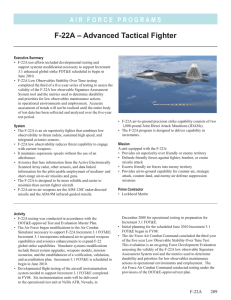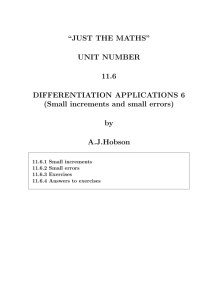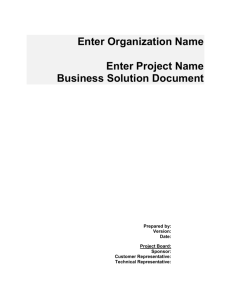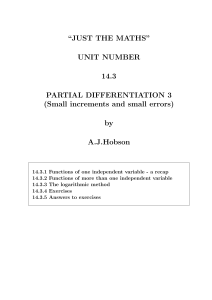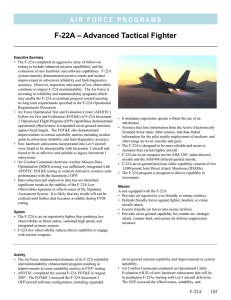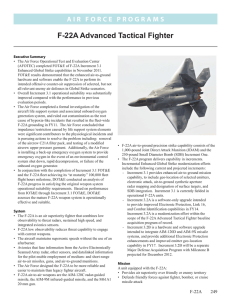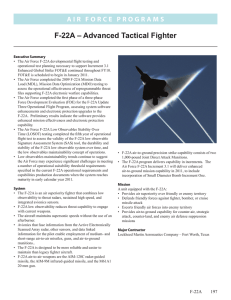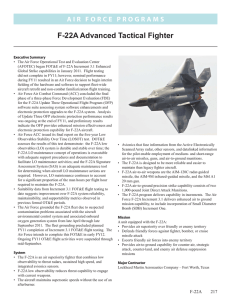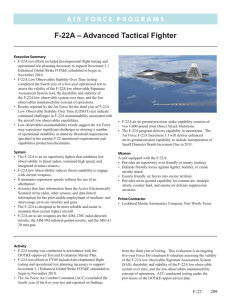F-22A Advanced Tactical Fighter
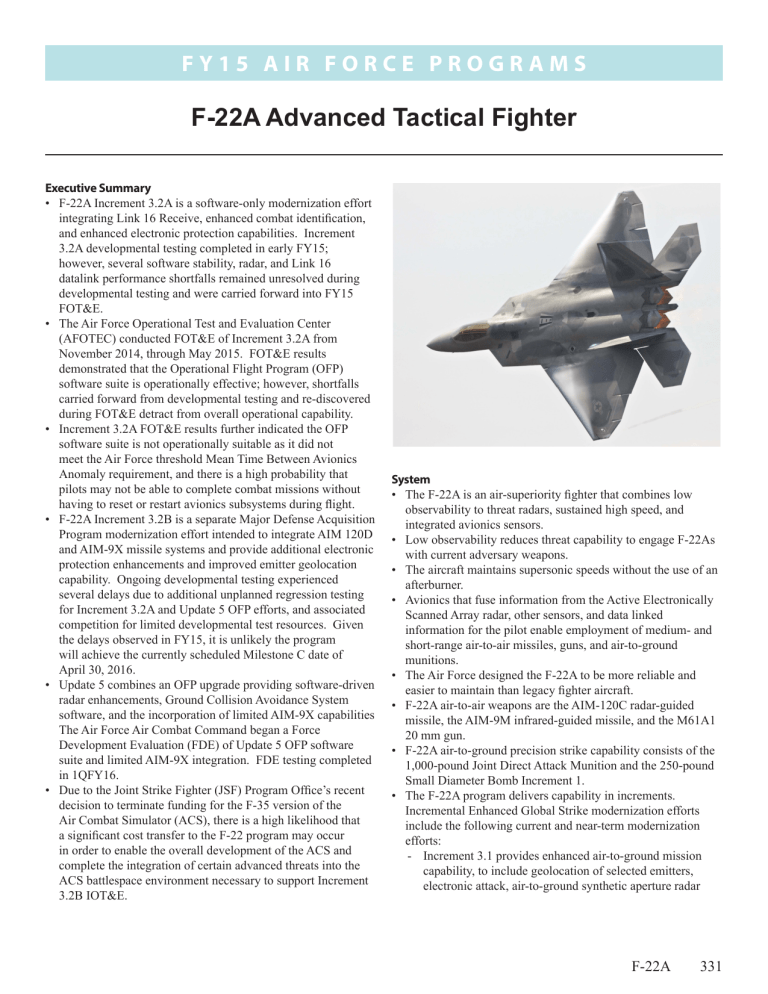
F Y 1 5 A I R F O R C E P R O G R A M S
F-22A Advanced Tactical Fighter
Executive Summary
• F-22A Increment 3.2A is a software-only modernization effort integrating Link 16 Receive, enhanced combat identification, and enhanced electronic protection capabilities. Increment
3.2A developmental testing completed in early FY15; however, several software stability, radar, and Link 16 datalink performance shortfalls remained unresolved during developmental testing and were carried forward into FY15
FOT&E.
• The Air Force Operational Test and Evaluation Center
(AFOTEC) conducted FOT&E of Increment 3.2A from
November 2014, through May 2015. FOT&E results demonstrated that the Operational Flight Program (OFP) software suite is operationally effective; however, shortfalls carried forward from developmental testing and re-discovered during FOT&E detract from overall operational capability.
• Increment 3.2A FOT&E results further indicated the OFP software suite is not operationally suitable as it did not meet the Air Force threshold Mean Time Between Avionics
Anomaly requirement, and there is a high probability that pilots may not be able to complete combat missions without having to reset or restart avionics subsystems during flight.
• F-22A Increment 3.2B is a separate Major Defense Acquisition
Program modernization effort intended to integrate AIM 120D and AIM-9X missile systems and provide additional electronic protection enhancements and improved emitter geolocation capability. Ongoing developmental testing experienced several delays due to additional unplanned regression testing for Increment 3.2A and Update 5 OFP efforts, and associated competition for limited developmental test resources. Given the delays observed in FY15, it is unlikely the program will achieve the currently scheduled Milestone C date of
April 30, 2016.
• Update 5 combines an OFP upgrade providing software-driven radar enhancements, Ground Collision Avoidance System software, and the incorporation of limited AIM-9X capabilities
The Air Force Air Combat Command began a Force
Development Evaluation (FDE) of Update 5 OFP software suite and limited AIM-9X integration. FDE testing completed in 1QFY16.
• Due to the Joint Strike Fighter (JSF) Program Office’s recent decision to terminate funding for the F-35 version of the
Air Combat Simulator (ACS), there is a high likelihood that a significant cost transfer to the F-22 program may occur in order to enable the overall development of the ACS and complete the integration of certain advanced threats into the
ACS battlespace environment necessary to support Increment
3.2B IOT&E.
System
• The F-22A is an air-superiority fighter that combines low observability to threat radars, sustained high speed, and integrated avionics sensors.
• Low observability reduces threat capability to engage F-22As with current adversary weapons.
• The aircraft maintains supersonic speeds without the use of an afterburner.
• Avionics that fuse information from the Active Electronically
Scanned Array radar, other sensors, and data linked information for the pilot enable employment of medium- and short-range air-to-air missiles, guns, and air-to-ground munitions.
• The Air Force designed the F-22A to be more reliable and easier to maintain than legacy fighter aircraft.
• F-22A air-to-air weapons are the AIM-120C radar-guided missile, the AIM-9M infrared-guided missile, and the M61A1
20 mm gun.
• F-22A air-to-ground precision strike capability consists of the
1,000-pound Joint Direct Attack Munition and the 250-pound
Small Diameter Bomb Increment 1.
• The F-22A program delivers capability in increments.
Incremental Enhanced Global Strike modernization efforts include the following current and near-term modernization efforts:
Increment 3.1 provides enhanced air-to-ground mission capability, to include geolocation of selected emitters, electronic attack, air-to-ground synthetic aperture radar
F-22A 331
F Y 1 5 A I R F O R C E P R O G R A M S mapping and designation of surface targets, and Small
Diameter Bomb integration. Increment 3.1 is currently fielded in operational F-22A units.
Increment 3.2A is a software-only upgrade intended to provide improved electronic protection, Link 16
Receive, and combat identification capabilities in FY15.
Increment 3.2A is a modernization effort within the scope of the F-22A Advanced Tactical Fighter baseline acquisition program of record. Increment 3.2A is currently fielding in operational F-22A units.
Update 5 combines an OFP upgrade providing software-driven radar enhancements, Ground Collision
Avoidance System software, and the incorporation of limited AIM-9X capabilities. Update 5 OFP FDE testing began in late FY15 and completed in 1QFY16.
Increment 3.2B is a separate Major Defense Acquisition
Program modernization effort intended to integrate
AIM 120D and AIM-9X missile systems and provide additional electronic protection enhancements and improved emitter geolocation capability. The Increment
3.2B IOT&E is currently planned for FY17.
Mission
Commanders will use units equipped with the F-22A to:
• Provide air superiority over friendly and non-permissive, contested enemy territory
• Defend friendly forces against fighter, bomber, or cruise missile attack
• Escort friendly air forces into enemy territory
• Provide air-to-ground capability for counter-air, strategic attack, counter-land, and enemy air defense suppression missions
Major Contractor
Lockheed Martin Aeronautics Company – Fort Worth, Texas
Activity
• The Air Force conducted all testing in accordance with the
DOT&E-approved Test and Evaluation Master Plan, FOT&E, and FDE test plans.
• Increment 3.2A developmental testing completed in early
FY15; however, several software stability, radar, and Link 16 datalink performance shortfalls remained unresolved during developmental testing and were carried forward into FY15
FOT&E.
• AFOTEC conducted FOT&E of Increment 3.2A from
November 2014, through May 2015. During the FOT&E, a software anomaly affecting legacy system performance deficiency was discovered resulting in a test pause and necessitating additional, unplanned developmental testing efforts to resolve the associated radar operation shortfall.
Following completion of the FOT&E, the Air Force Air
Combat Command released the Increment 3.2A software OFP for installation in operational F-22A units beginning in July
2015.
• Increment 3.2B developmental testing continued throughout
FY15, but experienced delays due to the additional regression testing for Increment 3.2A and Update 5 OFP software suite.
The Air Force is projecting a March 2016 Milestone C, and
IOT&E is projected to begin in spring 2017.
• The JSF Program Office has recently announced that it plans to cancel the development of the Lockheed-Martin F-35 simulation and transfer the project to a government team.
Both F-22 and F-35 JSF simulations currently share a common facility and software environment, including the battlespace environment and threat models. Each program leverages new threats and other capabilities added by the other. The
ACS is a Lockheed-Martin facility that provides the F-22 operational test community the ability to simulate dense threat environments that cannot be replicated in open air. It has been used successfully for IOT&E and FOT&E since 2004.
The ACS includes man-in-the-loop and OFP in the-loop F-22 systems, and capable man-in-the-loop adversary systems.
The F-22 Program Office plans to use the ACS for
Increment 3.2B for operational effectiveness trials during
FY17 IOT&E.
Several ACS upgrades are required to implement new 3.2B capabilities and to develop and integrate new weapons and threats into the ACS battlespace environment to support operational testing.
Increment 3.2B also requires the integration of new weapons on the F-22 simulation. The AIM-120D model has not yet been delivered to ACS by the weapon vendor.
• Air Force Air Combat Command began an FDE of the Update
5 OFP software suite. The FDE completed in 1QFY16.
Assessment
• Results of Increment 3.2A FOT&E testing demonstrated that the OFP suite is operationally effective; however, several unresolved radar and Link 16 datalink performance shortfalls carried forward from developmental testing and discovered during FOT&E detract from overall operational capability.
The Increment 3.2A OFP is not operationally suitable as it did not meet the Air Force threshold Mean Time Between
Avionics Anomaly requirement. Furthermore, based upon the demonstrated software stability performance during the
FOT&E, there is a high probability that pilots may not be able to complete combat missions without having to reset or restart avionics subsystems during flight.
332 F-22A
F Y 1 5 A I R F O R C E P R O G R A M S
• Increment 3.2A cybersecurity testing consisted of compliance checks on security controls. Increment 3.2A did not meet standards for multiple compliance checks.
• Increment 3.2B developmental testing experienced several delays due to additional unplanned regression testing for Increment 3.2A and Update 5 OFP efforts, and associated competition for limited test resources. All F-22A modernization efforts and increments are tightly coupled, and recent years’ reduction in developmental test force aircraft and personnel leaves little margin for unanticipated regression testing and correction of critical deficiencies when discovered in operational testing. Given these factors and delays observed to date, it is likely that the Air Force Milestone C decision will slip to late FY16.
• Update 5 OFP FDE testing to date included five AIM-9X missile live fire trials; a first for the F-22A operational test community. Four of the five performed nominally, yet the fifth failed to guide to the intended target. The root cause of the miss is under investigation.
• The primary schedule risk for completing ACS weapons model is the integration of a validated AIM-120D model. Delivery of the Raytheon AIM-120D model to Lockheed Martin for incorporation into the ACS is behind schedule. Other weapons and threats appear to be on track for planned delivery to support Increment 3.2B IOT&E.
• Due to the JSF Program Office's recent decision to terminate funding for the F-35 version of the ACS, there is a high likelihood that a significant cost transfer to the F-22 program may occur in order to enable the overall development of the
ACS and complete the integration of certain advanced threats into the ACS battlespace environment necessary to support
Increment 3.2B IOT&E. Fully-funded ACS capabilities are required to support F-22 Increment 3.2B IOT&E adequacy, regardless of whether or not F-35 funding is available.
Recommendations
• Status of Previous Recommendations. The Air Force continues to address previous recommendations, but did not resolve Increment 3.2A software anomalies and performance shortfalls before proceeding to formal AFOTEC FY15
FOT&E.
• FY15 Recommendations. The Air Force should:
1. Place increased emphasis and devote necessary resources to ensure system performance shortfalls identified in developmental testing are effectively resolved before proceeding with operational testing.
2. Improve F-22A avionics software stability to support operational mission execution and meet Air Force software stability requirements.
3. Ensure the adequacy of the force structure and schedule margins necessary to support forthcoming F-22A developmental testing efforts
4. Ensure adequate funding of ACS capabilities for F-22 operational test and evaluation regardless of F-35 funding decisions.
5. Ensure AIM-120D models are delivered and incorporated into the ACS to meet Increment 3.2B scheduled FY17
IOT&E.
F-22A 333
334
F Y 1 5 A I R F O R C E P R O G R A M S
